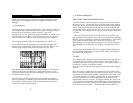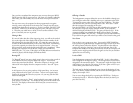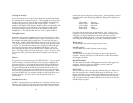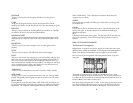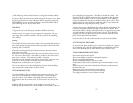
RESTRICTIONS ON PLAY
A) A player may only move a man to a point which is:
1) vacant,
2) already occupied by one or more of his own men, or
3) occupied by a single enemy man.
In the case of (3) the enemy man is removed from the point and placed on
the bar
- see the section below on Hitting an Enemy Man (or Blot)
If a player has two or more men on a point, then he is said to have made
that point , and his opponent’s men may not land on it. For this reason, it
is a good idea to try to make a number of points that are adjacent to each
other, since this will impede the progress of your opponent’s men around
the board, and will often leave him with no way to use all or part of his roll.
There are no limits to the number of your own men that can occupy a
point at any one time.
b) If a man may move, he is obliged to do so. He cannot pass
c) A player must, if possible, play both parts of his role. As an example, let
us see what happens if red rolls a 6-1 in the following position.
By moving the man one step from the 10 point red would leave himself
unable to move either man six steps because of the two black blockades .
So this particular play is illegal
because there is an alternative play in which red uses both the 1 and the 6 -
he may move his man from the 20 point to the 19 point and then move
either man six steps. This play makes use of use of both the one and the
s i x .
d) If it impossible to use both parts of a roll a player must, if possible, use
the higher
11
clockwise, the black men move counter-clockwise.
The Start of Play
In a game between two human players each player normally rolls one die to
determine who starts. The player who rolls the higher number makes the
first move - if they both roll the same number they must roll again. It is
therefore impossible for the very first roll
played in a game to be a double. At this time, if the doubling cube is being
used, the point value may double.
In a game between two human players, on the first move of the game the
player moves his men according to the two numbers rolled by himself and
his opponent. At the start of each subsequent move, the player rolls both
dice himself. His choice of moves is determined by the numbers that
appear on the dice when they are rolled.
Once a game has begun the players take turns to move.
Making Ordinary Moves
If the player’s roll of the dice results in a mixed roll such as 3-5 or 6-1,
then he moves one of his men the number of steps indicated by one of the
dice, and another of his men (or the same man) the number of steps
indicated by the other die.
Here red moves first, and the roll is 3-1. There are many ways to play this
r o l l .
DIAGRAM OF
THE INITIAL
POSITION
One way is to move a man one space from the 6 point and then another
man 3 spaces away from the 8 point. Then both these men will be
occupying the 5 point.
10




